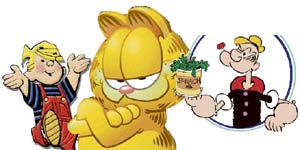|
WONDER
YEARS
When Garfield
turned 29 recently, it was celebration time for the numerous
fans of the cat with an attitude. With Tintin a doddering 77,
and Archie reaching out for his walking stick at 66,
Varuni
Khosla cheers hard for Garfield, the baby of the toon
family, and other classic toons
 THE
twentyninth birthday of Garfield the Cat on June 19 was
celebrated around the world by its fans, but there have been in
the recent past, a number of significant ó though quieter ó
birthdays in the toon kingdom. THE
twentyninth birthday of Garfield the Cat on June 19 was
celebrated around the world by its fans, but there have been in
the recent past, a number of significant ó though quieter ó
birthdays in the toon kingdom.
Popeye turned 78
on January 17, Tintin became an aging reporter at 77 in March,
Fred Flintstone noticed the first signs of grey hair as he blew
the candles on his 41st birthday in February and
Dennis the Menace neared retirement at 56 on March 12.
Each toon birthday
was significant and an occasion for publishers and TV channels
to make some more moolah. Every year, birthdays of these cartoon
characters become occasions for a new marketing thrust,
resulting in a veritable fortune for all connected to the
comic character.
But in this age of
interactive TVs, robots and instant gratification, is it
possible to sustain the appeal? Would children in 2029 be
interested whether Popeye turns 100 or 11 years later Archie too
becomes a centurion? Such cults can definitely not last in
modern times ó or can they?
"One can
never be on sure ground while predicting the taste of
children," says psychologist Vandana Mhatre. "Who
would have expected Dennis the Menace and Donald Duck to appear
on school lunchboxes? Or who could have expected an under
achiever like Beetle Bailey to become a success?"
But the truth is
that for one success, there are a dozen failures. Old-timers
would remember Sad Sack, a cartoon character of the 1960s and
í70s that almost became a cult but then it suddenly
disappeared. Or, for that matter remember He Man and She-Ra?
They just vanished.
Secret
of success
What is it that
separates a great cartoon from an ordinary one? Dr Mhatre has a
simple explanation, "Itís like any book or movie. Whatís
most important is a good storyline with a proper beginning,
middle and end. If thatís there, everything else will take
care of itself and the appeal will be instant."
So, what are the
other secrets of a successful cartoon that will transcend
generations?
Many say it is the
family environment. The relationship between couples and their
children and friends is timeless. Take for, instance, the
Flintstones or Dennis. Their aspirations, problems and joys are
the same as of any normal family today. Thatís why they are
ageless.
But even here, it
is absolutely essential to update a character without affecting
its timelessness. In fact, the late Hank Ketcham, creator of
Dennis the Menace, used to say that while Dennis didnít change
over the last 50 years, the world around him changed. Thatís
why he had to change him.
In the í60s
Ketcham replaced the radio with a TV, in the í70s he brought
in the skateboard instead of the hoopla. In the í80s he
introduced Dennis to computers and in the í90s came the palm
top and digital diaries.
But only the
gizmos changed. Everything else remained constant. His mother
and father were and still are the same, so are his neighbours,
the Wilsons and his friends, Joey and Margaret.
However,
psychologists say that the disturbing trend is that kids are
shifting from innocence to violence in cartoons. Says Dr Mhatre,
"The Tom-and-Jerry-type entertainment is today giving way
to real violence that can be correlated with aggression rather
than fun."
It is the teenaged
boys who seem to like violence in cartoons but the silver lining
here is that the novelty soon wears off. So, in the end only
classic toons have a lasting appeal. Specially toons that have
wide-eyed innocence around them.
Universal
appeal
Toon animals never
seem to age and stay in a kind of a suspended time warp where
nothing ever dates ó an endearing feature as far as sales are
concerned. Garfield the cat who was born in an Italian
restaurant in 1978 has grown into a worldwide celebrity. His
antics with his clueless owner, Jon Arbuckle, his drooling doggy
pal, Odie, and his teddy bear, pooky, bring laughter to
millions.
Or take Tom and
Jerry. Their appeal has transcended generations. Parents feel
secure with such creatures and introduce them to their kids.
Usually both the generations end up laughing at their antics.
The most common
denominator of cartoon success, however, is a sense of fun.
"So many of the gags are those that all ages
understand," says Dr Mhatre. Which in a way explains the
timeless appeal of toons like Archies, Dennis the Menace, Hagar
the Horrible, Beetle Bailey, Fred Flintstone, Tintin and Tom and
Jerry. ó NF

|